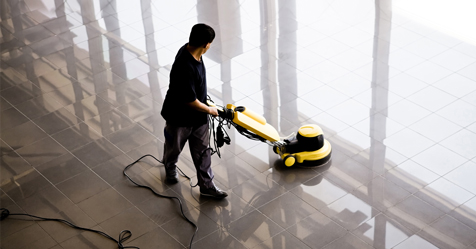High-traffic areas add extra challenges to the cleaning process in any type of building. In your building, high-traffic areas could include one or more of the following: stairways, lobbies, throughways, entrances and exits, primary and secondary hallways, restrooms, cafeterias, elevators, manufacturing areas, or excessively busy and soiled areas.
This may sound like the entire building, and in some cases, it is. These areas are where high levels of soil track into a building, and if not removed, result in aggressive wear of surfaces and finishes.
When planning floor care tasks and scheduling service in high-traffic areas, the following tips can help you get the job done quickly and safely.
Implement Prevention Techniques
Prevent soil from entering the facility by capturing it at entrances and exits with 12 to 15 feet of matting and regular vacuuming. Frequently dust and damp mop all hard surface floors within 25 feet of entrances and exits. During inclement weather, go the extra mile by protecting hard floors with additional matting.
Staff Appropriately
Be flexible; it’s not about what’s easy or convenient for you or your staff. Consider altering or staggering start times or using part-time staff and independent contractors to give you the most flexibility to quickly respond to changing service needs.
Pick the Best Time
Schedule tasks when areas are closed or traffic/use is at its lowest. If you must service areas when they are occupied, look at the possibility of closing down or blocking off small sections of the area. Consider closing off one-half or one-third of an area until all of the area is complete. Use physical barricades or barriers to reroute traffic; wet floor signs alone are not adequate for this purpose.
One approach is to connect caution tape between signs, cones, chairs, and stationary objects. Even when using tape or barricades, don’t leave high-risk areas unattended, as there may be building occupants who don’t think that staying out of the area applies to them. Be willing and ready to verbally remind tape jumpers that the area is unsafe, closed to through traffic, and they need to carefully and immediately exit the area. Be polite, professional, and helpful by suggesting an alternative route and letting them know when the closed area will be safe for entry.
Review Past Schedules
Collect and review historical data as a reference point for learning which tasks need attention in your facility and when. You will find consistencies and similarities throughout a period of years that can provide a place to start when planning future service schedules.
Schedule More Frequent Service
To keep high-traffic areas in good shape, and in order to maintain acceptable levels of quality, health, safety, and appearance, it may be necessary to increase service frequency. Certain days of the month and times of the day are known as being high-traffic periods. Times of bad weather—specifically wind, snow, and rain—can immediately alter floor care needs in a building.
Prevent Slips and Falls
Hoses, handles, and electric cords running across or even along high-traffic areas are accidents waiting to happen. Make sure there is good lighting and proper signage so people can clearly see and know work is taking place in the area. Learn to think about and see potential risks before they appear, and then be willing to take immediate steps to reduce or eliminate the potential risk—especially in high-traffic areas.
Speed Up Drying
Use quick-dry finishes and cleaners and don’t over-apply solutions. Keep an eye on interior and exterior humidity and temperatures and, if possible, plan floor care tasks for when the temperature is between 60 to 75 degrees Fahrenheit and the relative humidity is 45 to 55 percent.
Use fans and air movers to reduce drying times. Allow for the self-leveling of liquids before beginning the speed-drying process. In extreme cases, when fast turnaround is required, support drying by adding a dehumidifier to small confined spaces.
Consider the Surface
Everything is in flux: New surfaces, new products, new procedures, even the people doing the work may be in transition.
We used to see and treat all flooring areas of the same type equally. We now know that different areas within a building have different soil, traffic, and service needs. The most effective way to maintain each area is to consider the specific needs of the area versus only taking into consideration the type of floor covering when putting together cleaning, maintenance, and restoration schedules.
Know Your Frequencies
Although a variety of flooring materials may be found in a building, all floor care procedures fall into one or more of the following four categories:
- Initial: First-time cleaning
- Daily/Routine: Light preventive cleaning tasks that repeat fairly frequently, but not every time the area receives service
- Periodic: Less frequent, light to medium cleaning tasks that remove soil and protect surfaces from soil abrasion, wear, or staining
- Restoration: More heavy duty, infrequent tasks that remove nearly all of the soil and finish from the actual floor covering, while restoring the surfaces to a like-new condition (or as close as possible to like-new condition).
If you are responsible for the cleaning or maintenance of a facility, you need to make sure that high-traffic areas receive adequate service frequencies to ensure the required level of care is provided on a consistent basis.
Different High-Traffic Areas Have Different Needs
Consider the unique characteristics and risks affiliated with various types of facilities. For example:
Education: These have concentrated times, days, and months when traffic will be especially high.
Health care: Appearance, sanitation, noise, and odors are a concern.
Retail outlets: Appearance, along with slip, trip, and fall risks, are of special concern.
Convenience stores: Early mornings, such as 3:00 to 5:00 a.m., may be a busy service window in 24-hour locations.
Industrial: Expect to find special types of soils and consistent periods of high traffic in specific locations of the building.
Commercial offices: Evenings, late nights, holidays, and weekends are the best times to do floor care in these spaces.
Airports: Constant policing and low-moisture cleaning are important on day and evening shifts; heavier floor care is done on second or third shifts. Access due to security concerns will slow down some projects.
Military bases, courthouses, and consulates: Security is No. 1; expect delays and observation.




